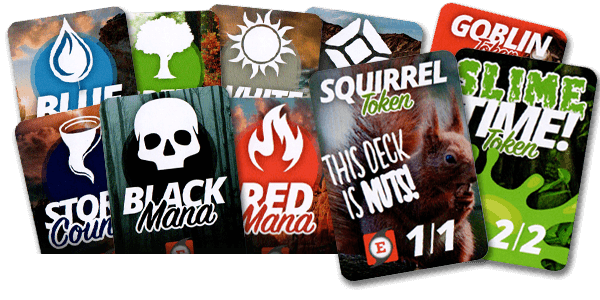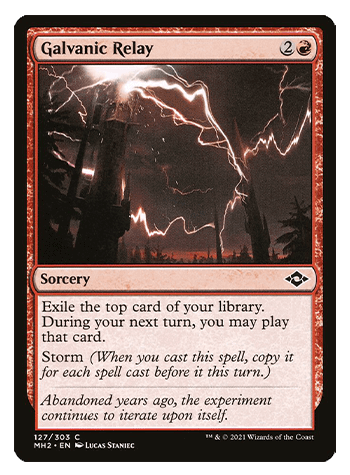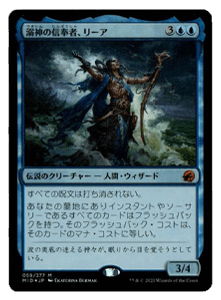Welcome to Pauper, the format with most of the fun fast mana of Legacy, but without the unfun answers like [[Force of Will]], [[Chalice of the Void]], and [[Thalia, Guardian of Thraben]]. The Storm mechanic has had a complicated history in Pauper, with most of the Storm cards that can directly win the game, like [[Grapeshot]], [[Empty the Warrens]], and [[Chatterstorm]], are banned. The remaining Storm cards act as engines for their respective decks. Cycle Storm, one of the premier combo decks in Pauper, is based around an innocuous seeming [[Raise Dead]] with Storm: [[Reaping the Graves]].
What is cycle storm?
Cycle Storm is the premier spell-based combo deck in Pauper. It typically attempts to win the game on turns 3-5, barring any disruption. Unlike Storm decks in other formats, Cycle Storm needs a critical mass of mana, cyclers, Storm count, and a few business spells. Unexpectedly, the worst ritual in the deck ends up being [[Dark Ritual]]. Combo turns end up requiring so much mana that the net two mana that [[Dark Ritual]] provides can feel underwhelming. The ritual that makes Cycle Storm tick is [[Songs of the Damned]]. Most of the decisions during a combo turn revolve around maximizing the mana that this ritual makes.
Balancing cycling creatures and Storm count at the beginning of the combo turn can be hard to figure out, and is the main skill in picking the combo turn. If one has lots of rituals and a [[Reaping the Graves]] to return cyclers, but not enough cyclers to return, that can be problematic. Having lots of cyclers, but a low Storm count (and low amount of mana) at the beginning of a combo turn is also not likely to win the game.
Cycle Storm
- 4 [[Drannith Healer]]
- 4 [[Drannith Stinger]]
- 4 [[Horror of the Broken Lands]]
- 4 [[Street Wraith]]
- 4 [[Imposing Vantasaur]]
- 3 [[Striped Riverwinder]]
- 4 [[Reaping the Graves]]
- 2 [[Exhume]]
- 2 [[Repository Skaab]]
- 1 [[Blood Celebrant]]
- 1 [[Dihada’s Ploy]]
- 4 [[Dark Ritual]]
- 4 [[Songs of the Damned]]
- 4 [[Cabal Ritual]]
- 3 [[Lotus Petal]]
- 4 [[Ash Barrens]]
- 4 [[Barren Moor]]
- 2 [[Island]]
- 2 [[Swamp]]
- 4 [[Pyroblast]]
- 2 [[Exhume]]
- 2 [[Darkness]]
- 2 [[Repeal]]
- 2 [[Gnaw to the Bone]]
- 1 [[Flaring Pain]]
- 1 [[Mountain]]
- 1 [[Forest]]
The Combo Turn
The combo turn can be as early as turn three, but waiting for an opponent to tap out and give a window is more often better. Earlier wins are theoretically possible, but unlikely enough that going for them is not the best plan. The first few turns of the game are spent developing land drops and cycling as many creatures as possible. Once one has a [[Reaping the Graves]] and a decent mix of rituals and cyclers in the graveyard, the combo turn may begin.
The most common trick to playing the deck is cycling in response to each copy of [[Reaping the Graves]]. As one picks up each creature, cycle as many times as possible and then let the next copy resolve. If you have watched Bryant in any of his cycle storm videos, he refers to this as the “Cycle Trick”. The goal of cycling like this is to maximize each copy of [[Songs of the Damned]]. This is done through keeping the highest amount of creatures in the graveyard at all times. For this reason, holding a [[Songs of the Damned]] until there is only one mana left can often be correct. Cards like [[Spell Pierce]] change this equation and should be played around accordingly. Opponents will generally counter rituals against the deck as mana is generally the choke point.
After repeating the cycle trick a few times, there should be a point in the game where there is plenty of mana floating and one has access to [[Blood Celebrant]]. This is when it is correct to start playing out copies of [[Drannith Stinger]] to ping the opponent to death. The math is relatively easy, but it is important to count to see if there is enough mana and copies of [[Street Wraith]] to win the game. Once the copies of [[Drannith Stinger]] are in play, the whole combo can operate at instant speed. This is important for when the opponent casts a life gain spell such as [[Weather the Storm]] or a protection spell like [[Prismatic Strands]]. Most of the time, it is possible to win in response and not have to worry about chewing through all that extra life. One important note is that [[Drannith Stinger]] triggers off of the activation of a cycling ability. The cycling ability does not actually have to resolve and draw a card for the trigger to happen, which allows for full comboing at zero cards in library.
The combo turn can be long, especially on MTGO. I would recommend practicing a few times in a one player game to get some of the clicking patterns down. Timing out can be a real possibility and during the combo turn, being exactly 100 percent optimal is not always required. The most precision tends to be required in the first few iterations of [[Reaping the Graves]] and when the copies of [[Drannith Stinger]] are in play.
Combo Pieces
While not currently in the deck, [[Mystical Teachings]] is a card that should still be kept in mind to help make the deck more consistent. Its purpose is to find [[Reaping the Graves]] and [[Songs of the Damned]] or some sideboard cards in select matchups. Casting an end of turn [[Mystical Teachings]] to find one of these pieces in order to untap and attempt to win is a common use case. During the combo turn, converting a [[Mystical Teachings]] into a [[Songs of the Damned]] because it is net positive mana can be a common line. Flashing it back to find another [[Songs of the Damned]] at the same time can also net mana, but it can lead to a situation where the deck runs out of rituals to draw.
[[Dihada’s Ploy]] is a cutely designed card from Modern Horizons 2 that Cycle Storm breaks in half. A secret about the deck is that it does use its life total as a resource, paying life to cycle [[Street Wraith]] and to filter mana through [[Blood Celebrant]]. Running out of life to do either of those things is a concern and because cycling counts as discarding a card, [[Dihada’s Ploy]] can gain it all back. It can also just filter to find more action and then be Jumpstart’ed back later during the combo turn.
Cycle Storm makes incredible amounts of mana, but the main problem is that this mana is all Black mana and the win condition of the deck is a couple of Red cards. There are also lots of Blue cards that are important to cast on the combo turn, such as [[Repository Skaab]] and [[Dihada’s Ploy]]. [[Blood Celebrant]] is the answer to all of these problems by converting the many Black mana from [[Songs of the Damned]] into more useful colors. Playing out [[Blood Celebrant]] on non-combo turns is a common line against decks that do not play exile removal. Even if [[Blood Celebrant]] is removed by a [[Lightning Bolt]] or something similar, [[Reaping the Graves]] can bring it back.
Innistrad: Crimson Vow brought one of the most influential printings for Cycle Storm since the Ikoria cyclers: [[Repository Skaab]]. What appears to be an odd little “[[Archaeomancer]] effect with set’s mechanic” allows Cycle Storm to fight through large amounts of life gain. One of the problems with the deck used to be running out of [[Songs of the Damned]] and/or [[Reaping the Graves]] and that could be game losing. [[Repository Skaab]] fixes this by being a creature that is able to rebuy a [[Reaping the Graves]] and then go to the graveyard, only to be picked back up by the same [[Reaping the Graves]]! It also is effectively three mana to return a [[Songs of the Damned]] because casting and Exploiting the [[Repository Skaab]] puts an extra creature card into the graveyard. [[Repository Skaab]] is not without its risks. If an opponent removes the [[Repository Skaab]] with the Exploit trigger on the stack, the [[Repository Skaab]] will not see a creature get Exploited and it will not trigger the second triggered ability on [[Repository Skaab]] and thus will not return an instant or sorcery card to hand.
[[Exhume]] is a returning card to this section. It used to be a sideboard plan to recur some of the large cycling creatures and beat down with them. While it is still good in this role, [[Repository Skaab]] supercharged [[Exhume]] and made the card maindeckable. Bringing back [[Repository Skaab]] directly to play allows for a kind of looping effect and saves on both quantity and color of mana. Having [[Exhume]] main deck also gives the flexibility to bring back a large creature game one against some blue decks, like the Faeries variants.
Cycling Tricks
Set up turn lines
Keeping a hand of good spells, but while only having [[Lotus Petal]] and [[Ash Barrens]] is reasonable. Cracking the [[Lotus Petal]] to basic landcycle and find a [[Swamp]] or other basic is good enough. Evaluating hands like this as an already mulligan to six is the easiest way to think about them.
One of the other good times to cycle [[Ash Barrens]] tends to be on the upkeep. This is especially true for a hand that has [[Barren Moor]] and [[Ash Barrens]] as its only lands. Cycling on the upkeep rather than in a main phase removes a potential land draw from the deck. It’s a small optimization, but most of playing this deck is combining a lot of small optimizations together to create the best chances for winning.
There are a couple types of cyclers in the deck: colorless creature cyclers, colored creature cyclers, and non-creature cyclers. Cycling the creatures with colored mana is best because the color of mana that one has to commit to those cyclers and getting creatures into the graveyard early helps improve [[Songs of the Damned]]. This leads to cycling generic cyclers next and non-creature cyclers last. Playing [[Barren Moor]] versus cycling it depends on how many lands one ends up with after cycling most of the other cards. Getting to three lands can be important for a lot of combo turns because having one black mana to bait a counter spell, another to really resolve a ritual, and a spare blue mana is a preferred set up.
When digging for a [[Reaping the Graves]], burning a [[Dark Ritual]] to cycle a couple of cards ahead of schedule is a common play. [[Dark Ritual]] tends to be the worst ritual on the combo turn because it makes the least amount of mana. Investing one early ensures Threshold for [[Cabal Ritual]] and more creatures for [[Songs of the Damned]] while digging for combo pieces.
Combo Turn Tactics
The most important and common line is the “Cycle Trick”, as mentioned above. Most combo turns utilize it a few times. In addition to cycling each creature as one returns it to their hand, the order in which the creatures are targeted is important. In situations with a high life total, returning all copies of [[Street Wraith]] before any other cycler is correct. On MTGO, this means targeting any non-[[Street Wraith]] creature with the initial copy of [[Reaping the Graves]] and then clicking on each copy of [[Street Wraith]] in the graveyard.
As a corollary to the cycle trick, when one has plenty of mana, but Storm count is too low, casting [[Songs of the Damned]], holding priority, and then casting [[Reaping the Graves]] increases the Storm count and is kind of like drawing a [[Songs of the Damned]] after cycling all of the possible creatures. Getting to return an extra creature and potentially making more mana can be valuable in a lot of situations. This tactic tends to be more case by case as the limiting factor most of the time is mana. Look for this line in the middle of the combo turn rather than at the beginning of it.
At the end of the combo turn, there are a couple of small optimizations that can help avoid fizzling. Drawing [[Ash Barrens]] mid-combo tends to be unfortunate, but with enough mana available, cycling those extra [[Ash Barrens]] to remove basic lands from the deck can be valuable. Because the combo turn draws such a high percentage of the deck, removing basics so that normal cyclers can draw live cards can be important. Mid-combo, casting [[Mystical Teachings]] to find [[Songs of the Damned]] as an expensive ritual can be good to avoid running out of mana. Doing this too often, such as flashing back [[Mystical Teachings]], can cause the deck to run out of [[Songs of the Damned]] and thus run out of mana completely, fizzling the combo turn. Playing [[Drannith Healer]] in order to gain life with a [[Blood Celebrant]] play or just “reduce” the cost of cycling [[Street Wraith]] helps avoid running out of life to filter mana to play [[Drannith Stinger]]s. Once the deck is cycling with a couple of [[Drannith Stinger]] in play, it is so hard to lose the game and the whole combo can be done at instant speed. If an opponent chooses to play a large life gain spell when there is a [[Drannith Stinger]] in play, one can often win in response.
Mulligan decisions
Hands with Cycle Storm tend to look weird. There are lots of cards that just read cycling and despite not being the best cards in the deck, they tend to be the best to open with. The deck needs a mix of rituals in hand and creatures in the graveyard, so opening on a bunch of creatures that then become those rituals tends to be good. A hand that is all rituals, lands, and a [[Reaping the Graves]] might not even be a keep, depending on the matchup, because the hand has nothing to do with all of that mana and storm.
Cycle Storm needs a lot of cards to function and tends to not mulligan amazingly. Fortunately, almost every card is a cantrip, so one landers and two landers are acceptable because churning through the deck quickly is so easy. Hands that contain lots of the clunkier cards like [[Reaping the Graves]], [[Repository Skaab]], or [[Exhume]] tend to be mulligans because one wants to find those cards later on the combo turn. No landers are rarely keeps, as hitting land drops and cycling with every mana is important to hit Threshold and increase the amount of mana that [[Songs of the Damned]] makes.
Sideboarding & match ups
Faeries
There are a couple different types of Faeries decks — Blue Red, Blue Black, and Mono Blue. Most of the time, Cycle Storm approaches the match up the same way. Being patient and looking for a window to go off with a piece of protection when the opponent taps out for something is the best game plan.
- -2 [[Drannith Healer]]
- -2 [[Imposing Vantasaur]]
- -1 [[Barren Moor]]
- -1 [[Dihada’s Ploy]]
- -1 [[Lotus Petal]]
- +4 [[Pyroblast]]
- +2 [[Exhume]]
- +1 [[Mountain]]
Generally, the Faeries decks do not have that many ways to answer a [[Striped Riverwinder]]. Reanimating one with [[Exhume]] can work both pre-board and post-board
Bogles
Bogles is a matchup that is all about racing. They do not tend to play that much interaction outside of [[Gut Shot]] in post-board games. Keeping hands that can win as fast as possible is key.
- -2 [[Striped Riverwinder]]
- +2 [[Darkness]]
[[Darkness]] can be akin to [[Time Walk]] in the matchup. In the past, this slot was taken by [[Spore Frog]], which worked better with [[Songs of the Damned]] and [[Reaping the Graves]], but Bogles playing four copies of [[Gut Shot]] makes the [[Spore Frog]] plan non-viable.
Boros Bully
Boros Bully is one of Cycle Storm’s best matchups. They tend not to have that much interaction and are incredibly slow at winning the game. They may have main deck [[Prismatic Strands]], but that card is beatable even without [[Flaring Pain]].
- -3 [[Striped Riverwinder]]
- +1 [[Flaring Pain]]
- +2 [[Repeal]]
It does not matter when one casts [[Flaring Pain]] relative to [[Prismatic Strands]]. The damage will not be prevented regardless. Postboard, the only card that Boros Bully picks up is [[Pyroblast]], which can make [[Repository Skaab]] slightly riskier. [[Repeal]] can help buy extra time or answer a graveyard hate piece like [[Relic of Progenitus]].
Burn
Burn can be a scary matchup! They race Cycle Storm aggressively with tools like [[Fireblast]] and all of the other best burn spells throughout Magic’s history. Choosing when to cycle [[Street Wraith]] can be difficult, but having lots of life gain in game one through [[Dihada’s Ploy]] is crucial.
- -2 [[Striped Riverwinder]]
- -1 [[Island]]
- +2 [[Gnaw to the Bone]]
- +1 [[Forest]]
As with other matchups [[Pyroblast]] can make [[Repository Skaab]] riskier. [[Gnaw to the Bone]] buys so much time, especially with how many creatures one could cycle by turn three.
Bryant’s 10-0 Challenge Run
If you have enjoyed this primer, there’s still more content! If you join the Storm Discord, there will be a message in the thread for this article about how to beat an onboard piece of graveyard hate like [[Relic of Progenitus]]!





